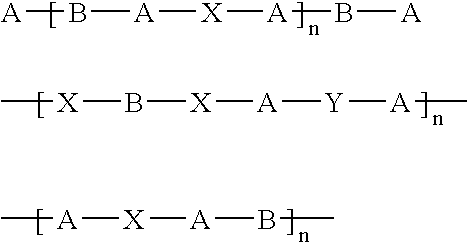Coatings for implantable devices comprising poly (hydroxy-alkanoates) and diacid linkages
a technology of diacid linkage and polymer alkanoate, which is applied in the direction of coating, polyester coating, prosthesis, etc., can solve the problems of affecting the effect of drug delivery
- Summary
- Abstract
- Description
- Claims
- Application Information
AI Technical Summary
Problems solved by technology
Method used
Image
Examples
example 1
[0124] Synthesis of multi-block PEG300-Poly(D,L-lactide), 30 / 70 weight ratio, coupled by succinic acid.
[0125] To a 250 ml, three necked flask, equipped with magnetic stirring, vacuum, and argon purge is added PEG300 (37.5 gm (0.125 mole). Using an oil bath, the PEG is heated to 105° C., and stirred under vacuum for two hours to remove water. The flask is purged with argon, and D,L-lactide (76.94 g, 0.534 mole) is added, and vacuum applied with stirring for another 30 minutes. After purging with argon, the flask is heated to 140° C., and polymerization is initiated by adding 10.8 ml of a 5% (w / w) stannous-octanoate-dry-toluene solution. After stirring for 24 hours, the reaction solution is cooled and poured into 500 ml of cold methanol to precipitate the polymer. The polymer is washed with methanol / petroleum ether and dried under vacuum. The triblock copolymer from above (25 g, 4.17×10−4 mole) and succinic anhydride (0.0417 g, 4.17×10−4 mole) is dissolved in 200 ml of anhydrous dich...
example 2
[0126] Synthesis of multi-block PEG600-Poly(D,L-lactide), 10 / 90 weight ratio, coupled by hexamethylene diisocyanate.
[0127] To a 250 ml, three necked flask, equipped with magnetic stirring, vacuum, and argon purge is added PEG600 (12.5 gm (0.0208 mole). Using an oil bath, the PEG is heated to 105° C., and stirred under vacuum for two hours to remove water. The flask is purged with argon and D,L-lactide (109.4 g, 0.76 mole) is added, and the vacuum applied with stirring for another 30 minutes. After purging with argon, the flask is heated to 140° C., and polymerization initiated by addition of 15.4 ml of a 5% (w / w) solution of stannous octanoate in dry toluene. After stirring for 24 hours, 1,6-diisocyanatohexane (10.13 g, 0.0602 mole) as a 10% solution in dry dimethylformamide is added and the solution stirred at 140° C. for another hour. The reaction solution is cooled and poured into 500 ml of cold methanol to precipitate the polymer. The polymer is washed with methanol / petroleum e...
example 3
[0128] Use of the polymer from example 1 as a biocompatible topcoat
[0129] A first composition can be prepared by mixing the following components: [0130] about 2.0 mass % poly(D,L-lactide); and [0131] the balance, acetone.
[0132] The first composition can be applied onto the surface of bare 12 mm small VISION stent (available from Guidant Corporation). The coating can be sprayed and dried to form a primer layer. A spray coater can be used having a 0.014 round nozzle maintained at ambient temperature with a feed pressure 2.5 psi (0.17 atm) and an atomization pressure of about 15 psi (1.02 atm). About 20 μg of the coating can be applied at per one spray pass. Between the spray passes, the stent can be dried for about 10 seconds in a flowing air stream at about 50° C. About 110 μg of wet coating can be applied. The stents can be baked at about 80° C. for about one hour, yielding a primer layer composed of approximately 100 μg of poly(D,L-lactide)
[0133] A second composition can be prep...
PUM
| Property | Measurement | Unit |
|---|---|---|
| Length | aaaaa | aaaaa |
| Biocompatibility | aaaaa | aaaaa |
| Compatibility | aaaaa | aaaaa |
Abstract
Description
Claims
Application Information
 Login to View More
Login to View More - R&D
- Intellectual Property
- Life Sciences
- Materials
- Tech Scout
- Unparalleled Data Quality
- Higher Quality Content
- 60% Fewer Hallucinations
Browse by: Latest US Patents, China's latest patents, Technical Efficacy Thesaurus, Application Domain, Technology Topic, Popular Technical Reports.
© 2025 PatSnap. All rights reserved.Legal|Privacy policy|Modern Slavery Act Transparency Statement|Sitemap|About US| Contact US: help@patsnap.com



